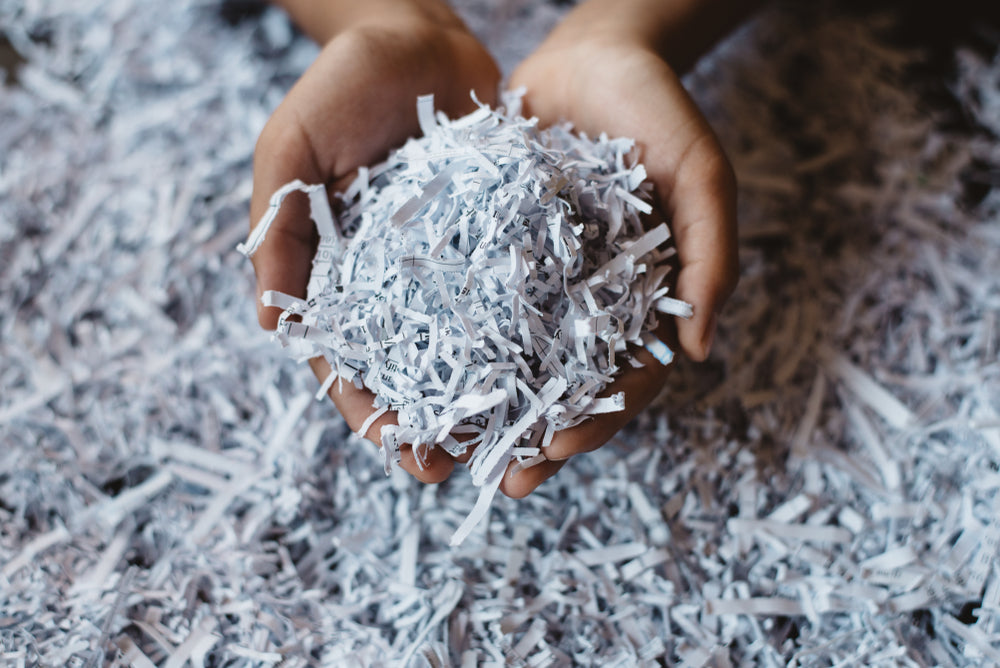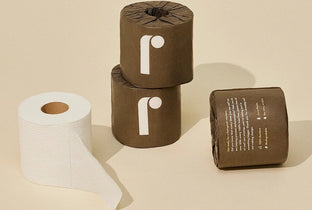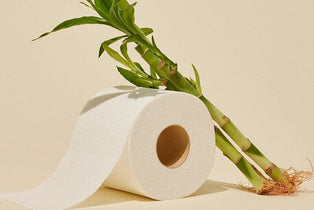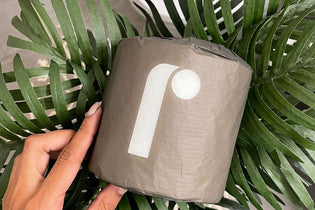
TLDR
From a very young age, most of us are taught the importance of recycling. Whether we learn it from our parents, pick it up in school, or hear it from the media, we quickly understand that recycling is a simple step that can significantly impact the planet’s health.
While many of us understand that recycling helps reduce energy use, curtail greenhouse gas emissions, and preserve the natural resources we rely on when it comes to the processes behind recycling paper, most of us might as well be looking at a blank page.
So how is paper recycled? In this article, we’ll take you step-by-step through the paper recycling process, from the moment it’s picked up by your local collection agency to the point it begins its second (or third, fourth, or fifth) life as a usable paper product. We will then address recycled paper uses, including recycled paper towels, toilet paper, tissues, and more.
What is the Process to Recycle Paper?
The process of recycling paper begins in the homes of individual consumers. Every day, people make recycling paper possible by being diligent about their recycling habits and properly learning how to recycle paper. That means knowing what types of paper waste can and can’t go into your recycling bin.
These specifications often depend on the city you live in and the rules stipulated by your recycling company, so it’s best to check those organizations if you aren’t sure what goes in the recycling bin.
Diligent paper recycling also includes:
• Separating your paper waste – While gathering your paper waste and storing it until it’s collected, you should keep it separate from your other recyclables. Metal, glass, and plastic all act as contaminants when it comes to recycling paper, which can make the paper more difficult to reuse.
• Recycling only appropriate materials – Are toilet paper rolls recyclable? Yes, but it should go towards cardboard recycling, not paper. Not all paper products can be recycled. Most-used paper products that are recyclable, like newspapers, cardboard boxes, and office paper. However, things like paper towels, store receipts, and disposable coffee cups cannot.
Your personal paper collection is only the first phase. Once you’ve sorted your paper recycling, your recycling service will come to transport it to a materials recovery facility, or MRF, where the true work begins.
Step #1: Decontamination
Once your paper recycling arrives at the MRF, it will go through decontamination. During this process, any non-paper contaminants are removed from the batch to prepare the paper for recycling.
Essentially, anything that isn’t a recyclable paper product is considered a contaminant. These include:
- Metal
- Glass
- Plastic
- Foreign object
Step #2: Sorting (and stored/baled)
After decontamination, the paper is sorted according to type and grade. When it comes to recycling, the grade of a paper product is determined by the length of its fibers. Each time a paper product is recycled, its fibers get shorter and shorter until the paper is eventually unusable. Most paper products can be recycled between five and eight times.
There are five grading categories for recycled paper. They are:
• Corrugated containers – This includes most cardboard. Delivery boxes, paperboard packaging, and the like are examples of the kinds of paper in this grade.
• Mixed paper – A variety of paper products fall into this category, including phone books, mail, paperboard, and publications like magazines and catalogs.
• Newspapers – Newspapers are among the most recycled paper products. In most cases, newspapers can be recycled up to eight times.
• High-grade de-inked paper – Envelopes, fancy stationery, letterheads, and copier paper all fall into this category. These paper products usually need to go through a de-inking process before they can be reused.
• Pulp substitutes – Shavings, clippings, and other bits of paper that are leftover at the mill are considered high-grade paper. For paper mills, they are a convenient alternative to virgin paper materials when making new paper products.
Once sorted, the paper is stored in bales while it awaits transport to a paper mill.

Step #3: Pulping
When it finally arrives at the paper mill, the paper has to be pulped. This involves running the paper waste through large machines known as pulpers that shred it into small pieces. The small pieces are also mixed with water and special chemicals that help break them down to their fibers.
The specific chemicals used in the pulping process may vary from mill to mill. In general, the most common chemicals used in paper recycling are:
- Surfactants
- Hydrogen peroxide
- Chlorine
- Sodium hydrosulfite
Step #4: De-inking and purification
Frequently, printed paper materials will need to be de-inked before continuing the recycling process. Usually, this comes right after the pulping process.
For de-inking, the pulp is placed inside of a flotation tank. There, air bubbles work to remove inks, dyes, and other impurities to give the pulp a paper-white look. During this stage, certain chemicals are also be used to aid in the process, like:
• Hydrogen peroxide – This chemical compound is sometimes used for de-inking, thanks to its bleaching properties.
• Surfactants – These are chemical compounds that reduce the surface tension of liquids. In paper recycling, they help release ink particles from the pulp. They also help keep ink particles separate once removed and generally improve the de-inking process.
Step #5: Screening
After it is broken down to paper fiber, it must go through another round of decontamination. The process involves pressing the fiber pulp mixture through screens cut with slots or holes.
This time, adhesives are the primary target, although other contaminants are also removed, such as:
- Plastics
- Coatings
- Fillers
- Ink particles
Step #6: Spinning
A final cleaning step is necessary after additives and contaminants are strained during the screening process. This step is known as spinning.
The paper is loaded into large cylinders that spin at very high speeds. The force of the spinning removes heavier particles from the paper and disperses them to the outer regions of the cylinder, leaving pure pulp at the center.
Step #7: Drying
Finally, the paper needs to be dried and pressed into paper form. This is accomplished in two phases:
- Pressing – Large metal rollers press excess water from the paper pulp. In some situations, a vibrating machine may be used instead, which allows the paper to retain a higher level of water.
- Rolling – Next, the paper pulp is passed through heated rollers that complete the drying process and transform the pulp into long rolls of paper.
Once the drying process is complete, the recycled paper is ready to be reused.
What is Recycled Paper Used For?
Recycled paper has a variety of uses. In fact, there’s a good chance many of the paper products you use daily are made from recycled paper, even if you don’t realize it. You can even learn how to make recycled toilet paper to use at home. The most common products that use recycled paper include:
- Tissues
- Toilet paper
- Paper towels
- Newspapers
- Printer paper
- Greeting cards
- Egg cartons
- Grocery bags
That said, the most popular use for recycled paper is the manufacturing of cardboard and paperboard boxes. In 2020, almost half of all recycled paper was used for this purpose. Aside from the brown boxes that immediately spring to mind, recycled paper is also used to make:
- Cereal boxes
- Pasta boxes
- Shoe boxes
- Gift boxes
- Beverage packaging
Typically, recycled paper is categorized into five distinct grades. These include:
• Ordinary grades – Consists of a large percentage of corrugated paper and board wastes, including unsold magazines, newspapers, and graphic papers
• Medium grades – Predominately unsold newspapers and sorted office papers that have insoluble adhesives that don’t exceed 0.25%
• High grades – Includes wood-free binders, letters, and heavily printed multiply boards and shavings
• Kraft grades – Unused corrugating material, including magazines, newspapers, stationery papers, and poly-coated material
• Special grades – A mixture of recovered paper and board, liquid board packaging, labels, envelopes, paper cups, and wet-strength wood-free papers

What Are the Benefits of Recycling and Reusing Paper?
The benefits of recycling and reusing paper products cannot be overstated. Aside from the benefits of recycling in general, recycling and reusing paper products, in particular, helps the environment by:
• Reducing landfill waste – Landfills are an integral part of how our waste is processed. When landfill space becomes overfilled, new ones have to be built. Unfortunately, landfills can be detrimental to the environment. This is because most garbage releases greenhouse gasses like methane while it decomposes.
• Saving trees – It’s estimated that the average American uses about seven trees worth of paper products each year. But recycling paper reduces the number of natural materials that have to be extracted to make new paper.
• Conserving water and energy – It isn’t just the trees that are spared when paper waste is recycled. Making new paper requires a lot of water and energy, and recycling paper saves on both fronts.
Reel Paper, No Additives
When it comes to doing your part to promote sustainability, lessen your personal environmental impact, and make a difference in the world, you don’t have to settle for weekly recycling. Making environmentally conscious decisions about the products you use every day is another excellent way of leaving behind a smaller carbon footprint.
At Reel Paper, we’re committed to building a better world for everyone. That’s why our 100% tree-free paper products are made entirely from recycled fiber or bamboo. Biodegradable, sustainable, and free of inks, dyes, chlorine, and fragrances, our products make it easier for everyday people to give back to the environment.
But we don’t only make environmentally-friendly products. We’re also committed to improving as many lives as possible by ensuring everyone has access to a clean, working toilet, no matter where they are.
Ready to join the solution? Shop Reel Paper today.
Sources:
Environmental Protection Agency. Paper Grades and Collections. https://archive.epa.gov/wastes/conserve/materials/paper/web/html/grade.html
Biz Fluent. Chemicals Used in Paper Recycling Mills. https://bizfluent.com/facts-5731899-chemicals-used-paper-recycling-mills.html
Forest Products Laboratory. Roles of Surfactants in Flotation Deinking. https://www.fpl.fs.fed.us/documnts/pdf2004/fpl_2004_zhao001.pdf
Recycle Nation. How is Paper Recycled https://recyclenation.com/2010/12/paper-recycled/
Green Tumble. How is Paper Recycled: Step by Step https://greentumble.com/how-is-paper-recycled-step-by-step/
American Forest & Paper Association. Does Paper Actually Get Recycled? The Industry Answers. https://www.afandpa.org/news/2021/does-paper-actually-get-recycled-industry-answers#
Global Citizen. Where Will the Trash Go When All the Landfills Are Full? https://www.globalcitizen.org/en/content/us-landfills-are-filling-up/
University of Southern Indiana. Paper Recycling Facts. https://www.usi.edu/recycle/paper-recycling-facts/#
Environmental Protection Agency. Paper Recycling Basic Information Details. https://archive.epa.gov/wastes/conserve/materials/paper/web/html/index-2.html#
Paper Index. Comparison of Waste Paper Grades. https://www.paperindex.com/academy/waste-paper/comparison-of-waste-paper-grades




0 comments